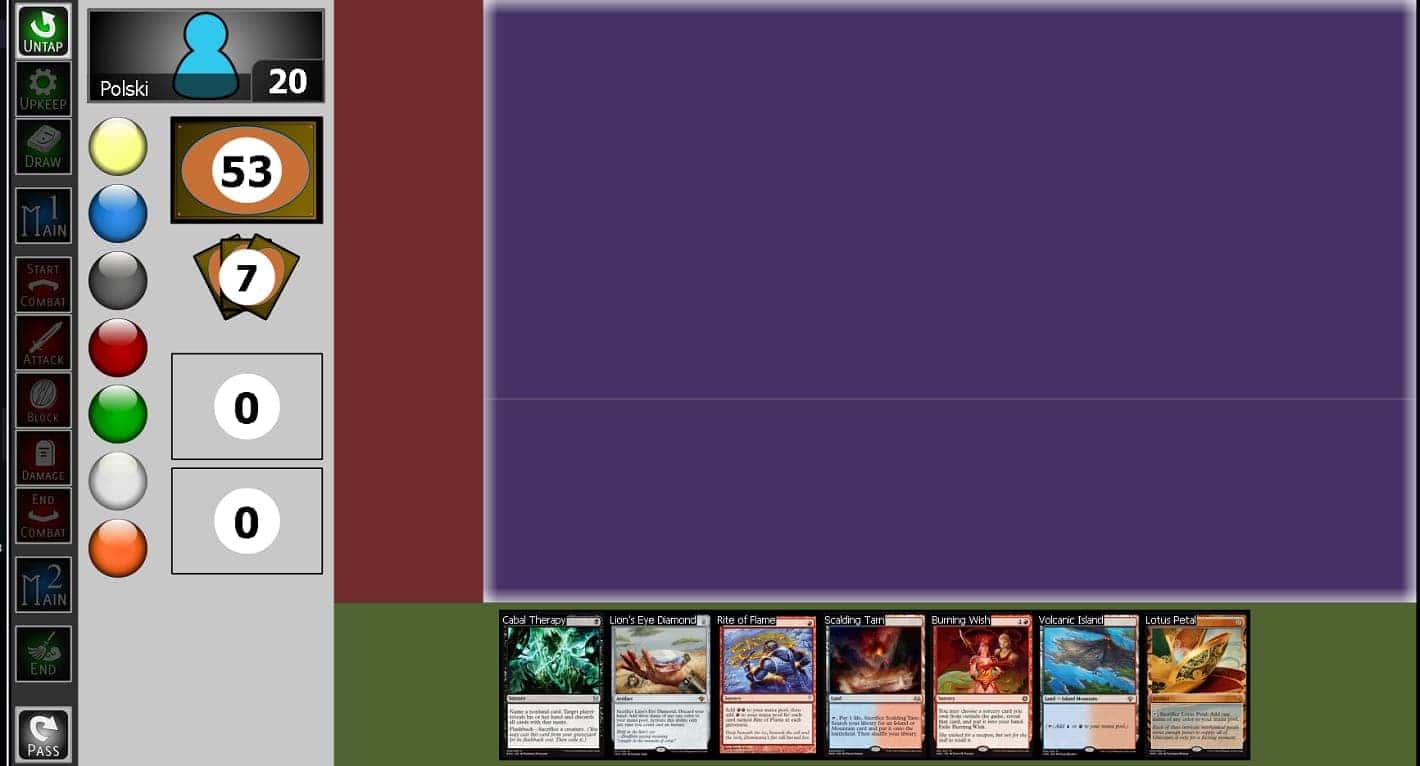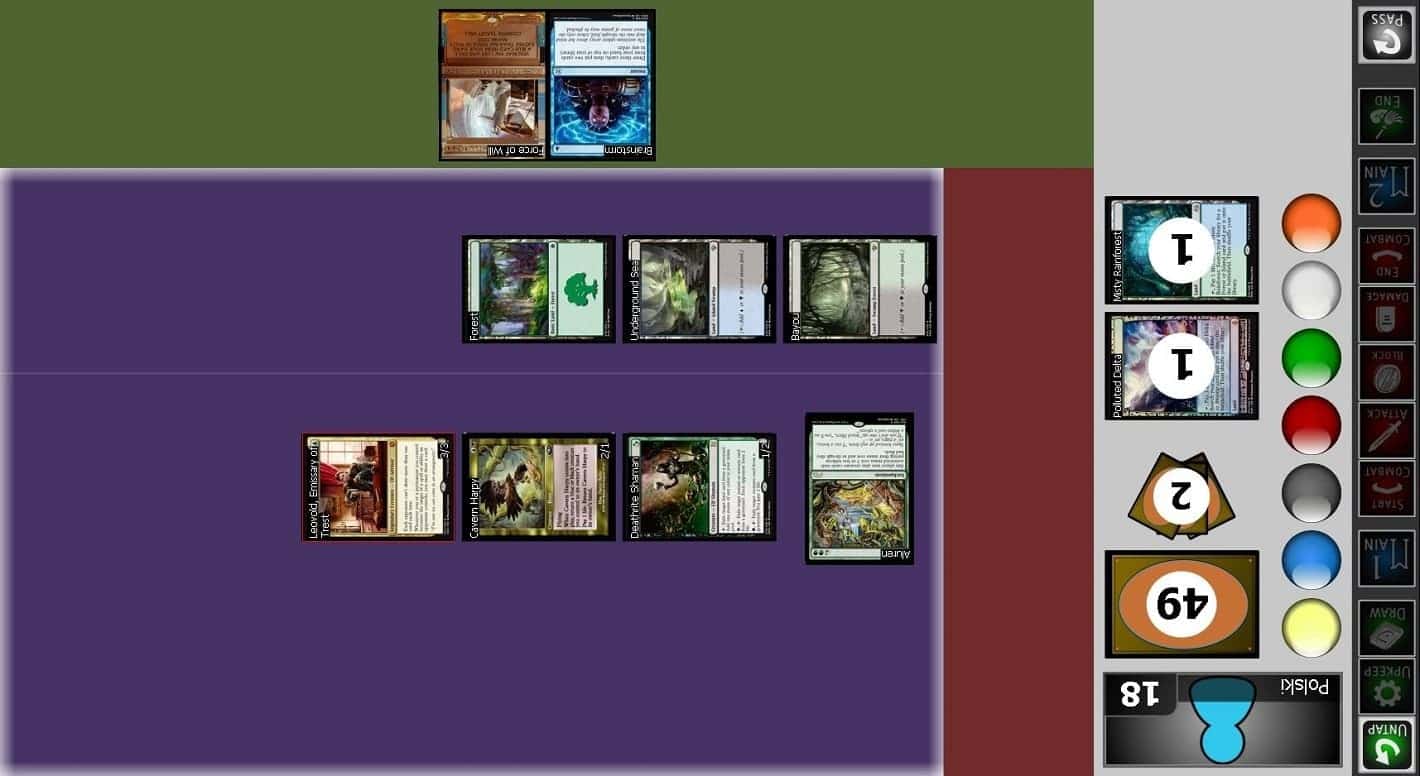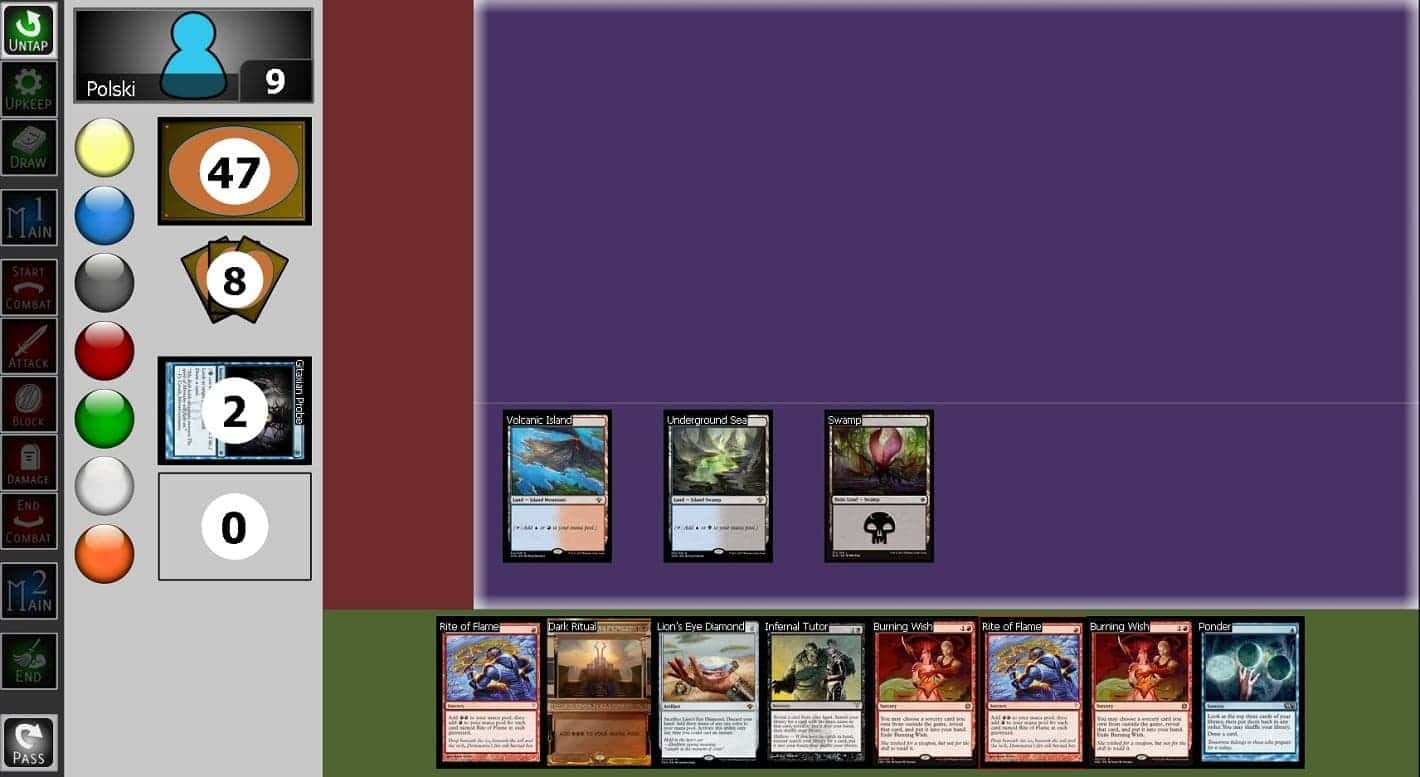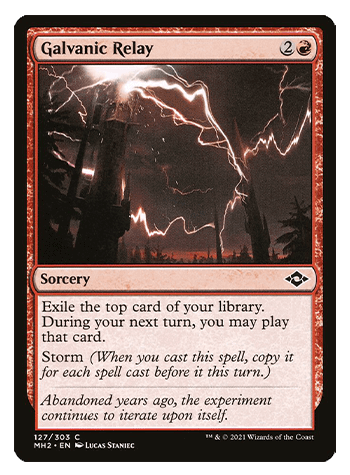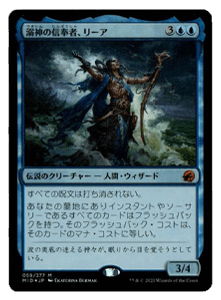Aluren is an archetype based around, and abusing, the card Aluren. It does this by having an instant speed combo, and a lot of value creatures to make removal spells worse. The combo is to resolve an Aluren to play Parasitic Strix + Cavern Harpy to return the Parasitic Strix, and then use the Cavern Harpy‘s second ability to return itself to keep repeating this process until the opponent is dealt lethal damage. If that plans go south or they don’t draw all of these cards then they resort to winning with value creatures like Deathrite Shaman, Leovold, Emissary of Trest, and Shardless Agent. Like most combo decks, they are still packed with a decent amount of disruption with cards like Force of Will and Cabal Therapy to both protect their combo and to slow down the opponent. A lot of Aluren players will tell you it’s often compared to Splinter Twin because it can play a normal game of magic with disruption and value creatures, but if you ever let your guard down they can just win out of nowhere. This makes it very tricky to play against, and often confuse opponents when it comes to sideboarding. You can’t board like they are a pure combo deck or creature deck because then they just beat you with their other angle. This deck is not very popular, so many players don’t practice against it often, so let’s not get caught up in this confusion, and have an actual game plan.
How does Aluren matchup against TES?
Aluren – This is their main combo piece, and what we have to worry about in regards to a quick kill. With Deathrite Shaman producing mana they can get this into play on turn three and then just win the game. For a deck full of creatures that’s still pretty fast. They have to have a very good hand in order to pull this off, but we have to keep this in mind when keeping or mulliganing. Hands that just cantrip a bunch of times and are slow could easily lose to a fast draw by the opponent. Another thing to consider is that Aluren gives creatures flash, so Leovold, Emissary of Trest could come down in response to a cantrip or right before a Tendrils of Agony in postboard games.
Force of Will, Cabal Therapy – This disruption suite is a recipe we should all be used to facing from all the Delver and other sultai/grixis decks, and we should be pretty comfortable with if you’ve been playing TES the past year. I am not going to go too much into this since this is standard by now, but at the end of the day just realize and know, that even though they are a creature based deck we can’t assume it’s always free to go for our combo. They could have counterspells, and this deck takes advantage of the flashback of Cabal Therapy really well, so just keep that in mind.
Leovold, Emissary of Trest – This is the single card in the matchup that affects how we play and how we sideboard. It plays a few annoying roles in the matchup, and it can range from not mattering to being back breaking, so when there is one in play it is our job to play in such a way to decrease it’s impact. We will get more into this in the sideboarding segment. Game 1 it is important to use our cantrips as early as possible, so Leovold, Emissary of Trest doesn’t shut them off. In the post-board games Empty the Warrens plays a much bigger role than Tendrils of Agony because if there is a Leovold, Emissary of Trest in play and we target them with 10 copies of Tendrils of Agony, then they get to draw 10 cards in search of a Mindbreak Trap or a Flusterstorm, that is the back-breaking scenario. If we go with a horde of goblins then it doesn’t interact with Leovold, Emissary of Trest at all and we make them have an answer in their hand, which hopefully we see their hand before going for it.
Deck List
- 4 Burning Wish
- 4 Infernal Tutor
- 4 Brainstorm
- 4 Ponder
- 4 Gitaxian Probe
- 3 Cabal Therapy
- 3 Duress
- 1 Empty the Warrens
- 1 Ad Nauseam
Ways to win this matchup
Killing Them and Our Game Plan
Our game plan changes pretty drastically depending on what game we are on, but game one is the most important for us, because it’s almost a must win. Postboard gets a lot harder, so it intensifies the importance of the first game. In game one we are free to kill with both Tendrils of Agony and Empty the Warrens because there are no copies of Mindbreak Trap and Flusterstorm that combo with Leovold, Emissary of Trest, and no wrath effects for our Empty the Warrens. The main thing we have to worry about in the first game is to not randomly die to their fast combo. The critical turns are usually between 2-3 game ones because of their lack of interaction. We may have to deal with 1-2 pieces of Force of Will/Cabal Therapy to set us back a turn or so, but that’s at most. Postboard it changes pretty dramatically. The games are going to slow down and we are looking around turns 4-5. They are going to have much more interaction with discard, counterspells, and wrath effects in the form of Golgari Charm or Toxic Deluge. Leovold, Emissary of Trest also gets much better because of the interaction with Tendrils of Agony targeting the opponent, so that will effect our sideboarding heavily. We will want either Xantid Swarm in play to not worry about Leovold, Emissary of Trest drawing into counterspells or just go for Empty the Warrens. The dangerous part of postboard is as a pilot we get too focused on trying to win through disruption that we always have to be aware of how close they are to just comboing off randomly and the power of Aluren. An example of the power that Aluren provides is that just because there isn’t a Leovold, Emissary of Trest in play and you may think we are green lit to go for Tendrils of Agony, but the opponent could easily just flash in a Leovold, Emissary of Trest mid combo, so always be aware of that interaction. Empty the Warrens is the safer bet if you don’t see a wrath effect and if they are aren’t close to killing us.
Sideboarding
-4 Ponder, -1 Island
+1 Bayou, +2 Chain of Vapor, +2 Xantid Swarm
At the end of the day Aluren is a combo deck and we don’t have time to mess around with a ton of cantrips because of their potential fast kill. They also have Leovold, Emissary of Trest, so that’s two strikes against Ponder. While we don’t necessarily need to answer Leovold, Emissary of Trest we should try to minimize its effectiveness, so we aren’t just cold to it. Typically Empty the Warrens is cut vs combo decks, but we leave it in as a way around Leovold, Emissary of Trest. Chain of Vapor plays two minor roles in that it can bounce a Leovold, Emissary of Trest when we want to go for a Tendrils of Agony without having to worry about its draw triggers. It is also there to buy us a turn if they have a quick kill by bouncing an Aluren. Most of the ways this deck interacts is through counterspells and Xantid Swarm helps us combo through them and guarantee that the coast is clear on our combo turn. It also negates the second half of Leovold, Emissary of Trest. If we target them with 10 copies of Tendrils of Agony and they draw 10 cards and find Flusterstorm or Mindbreak Trap then they can’t cast them. There really are no hard rules for this matchup, but hopefully these concepts will help guide you through the matchup.
Game Play
Starting off with the very first game and with our opening hand:
So, what does this hand do? Starting on turn 1 we could make 10 goblins and then flashback a Cabal Therapy, going down to 9. We could alternatively wait a turn in order to use a Cabal Therapy to try and clear the way of a Force of Will and then we would be able to get both sides of Cabal Therapy. It would also give us a draw step in order to build more storm or more mana to potentially Dark Petition for an Ad Nauseam.
I ended up going for the first option with just going for it on turn 1. If they don’t have Force of Will then we can flashback Cabal Therapy naming like Deathrite Shaman since it’s a good blocker vs 1/1’s, but could also help them ramp into a quick kill of their own. Since there is this game 1 and they don’t have any wrath effects we only have to worry about three things with this line, Force of Will, enough early blockers to prevent us from winning, and a quick kill of their own. Going for it on turn 1 plays around two of the three. We get to take a Deathrite Shaman, and force them to have their combo one turn earlier than if we go for it on the second turn, but we do open ourselves up to Force of Will, but I took that risk and luckily it paid off. He did not have a Deathrite Shaman or a Force of Will. Would you have taken the same line? Waited another turn? Done something entirely different?
1-0
In this second game the scenario is pretty developed and we get in a situation where we cast Gitaxian Probe, so all information is known, and here is the opponent’s board and hand along with our side of things.
This is one situations where there’s a ton of possibilities and avenues we can take, and since we don’t have a discard spell it’s also really hard to talk out the best lines because we don’t know where the opponent could use their Force of Will. There’s a lot to consider here. I’m not going to break down every possible line here because there are so many, and the decision trees are quite extensive, but I will give you a breakdown and the mentality that we should be thinking about to help you form your own line.
- We need to get through a Force of Will and either try to bait them into countering a tutor that we don’t need or start off with a Burning Wish for an Empty the Warrens and go that route making a ton of goblins. This plays around everything that’s on the board and definitely the more definitive route of what it does and what it plays around. The only concern is the opponent finding a sweeper or the remaining piece for their combo.
- We have to consider Leovold, Emissary of Trest here because it is a big factor. It turns off our Ponder and if we target the opponent with a Tendrils of Agony they will be able to draw a bunch of cards looking for a Mindbreak Trap. With Tendrils of Agony I think the best route would be to try and see if there’s a scenario where we can cast Tendrils of Agony then using another Burning Wish to Past in Flames Tendrils of Agony again. This would trigger Leo again, but would force them to draw two copies of Mindbreak Trap, which is still pretty risky, but if you’re willing to take this risk then doing it twice and hoping they brick at least one of the two Leovold, Emissary of Trest triggers is better than just relying on the first. The Past in Flames line may require a setup and passing of the turn though, so lot’s of pros and cons to both options.
- I think passing the turn there isn’t a horrible idea, but it is not what I would do. Passing the turn makes Empty the Warrens much worse and they could just draw their last remaining combo piece. The opponent could decide to get aggressive and cast Brainstorm looking for the remaining combo piece or another form of hate, so I would be aiming to going for it this turn.
The TES community is one I love for many reasons, but my favorite reason is that we can talk through plays and lines and it’s interesting to hear how other people play the deck and approach situations. I think this last example is definitely one where people will fall back on their instincts, play style, or their approach to the deck because there is no clear optimal line or choice and every line has it’s pros and cons and risk that could result in losing. This scenario is a great opportunity to hear how other people approach the same deck we play and how their thought process led to the decision that they made which you may not have ever seen.
One good tip that I think we all know, but is hard to truly grasp and understand is just because we win doesn’t mean our line was correct or if we lost that we made the poor decision. It’s why I am always hesitant to post the outcome of some of these scenarios because I don’t want that to indicate whether it was a right or wrong decision because often it doesn’t matter.
I hope we can have a discussion on the last scenario and I learn from the community just as much as the readers, but until the next one let’s keep the conversation going.








